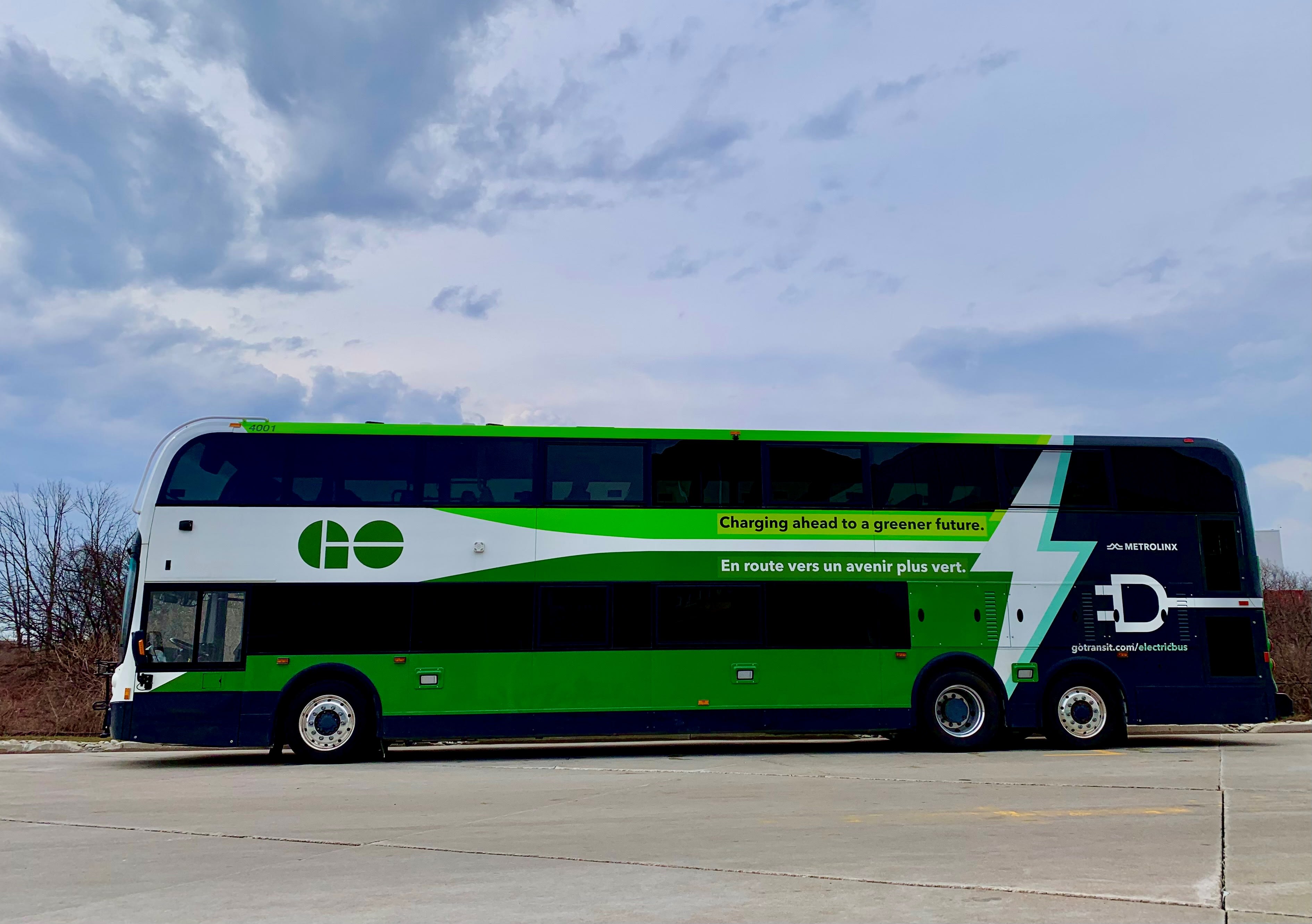Share
This Metrolinx initiative electrifies Ontario’s bus fleets
Metrolinx’s Transit Procurement Initiative hits another milestone.
May 16, 2024
Transit agencies across Ontario are getting a surge of support through a Metrolinx program that helps them lay a foundation of sustainability.
It’s all part of a six-phase roadmap to fleet electrification, and through the Transit Procurement Initiative, a new milestone on that path has now been reached.
A zero-emission battery electric GO bus. (Metrolinx photo)
Progress made so far – and next steps
In 2022, Metrolinx commissioned a study on the feasibility of electrifying transit fleets across Ontario.
Just last year, tangible progress was made, with a joint purchasing contract for 12-metre battery electric buses awarded to Winnipeg manufacturer New Flyer.
The contract allows agencies in Barrie, Belleville, Brantford, Kingston, Leamington, Milton, Sault Ste. Marie, Stratford, Sudbury and Thunder Bay to put in orders for brand new electric buses at a lower overall cost.as part of a collective bulk buy.
Now – a contract has been awarded to ABB E-Mobility on behalf of seven Ontario transit agencies for multiple types of charging systems that will keep electrified buses and municipal vehicles powered up.
This includes a wide range of charger varieties, from low-powered options for municipal and transit support fleet vehicles, all the way up to high-powered on-route charging systems for transit buses.
Artist's rendering of a fleet of electric buses recharging using pantograph style chargers. (ABB photo)
For the buses, there is an expansive range of in-depot charging options. The contract includes ~150 kW plug-in chargers that can be wall-mounted, pedestal-mounted, or roof-mounted on a manual or electric cable reel system – as well as pantograph chargers which are mounted to the roof of the transit depot.
There will also be an option for on-route charging – in the form of a pantograph charger mounted on a mast or arm with power levels up to 600 kW – capable of providing a top-up charge within minutes.
With the charging systems contract being awarded, the Transit Procurement Initiative (TPI) team is now focusing on phases four and five of the Fleet Electrification Roadmap.
Phase four, the next step on the road map, is a joint purchasing contract for smaller, specialized electric buses that can be used for paratransit, on-demand services or shuttle applications.
Phase five will consist of a full turn-key package for electric bus charging. The current charging stations joint purchase is meant to support transit agencies with immediate need for chargers for electric buses they already have or will purchase, whereas the turn-key package is a longer-term solution where agencies will outsource the design, build, procurement and maintenance of the chargers and electrical equipment to an external vendor to manage.
Fully electric Kingston Transit buses, one of the transit agencies taking part in TPI.
This is important as transit agencies begin to procure higher quantities of electric buses and their transit facilities require more substantial upgrades to meet the power requirements for electric bus fleets.
TPI helps further by offering Metrolinx’s technical and managerial expertise, overseeing contracts to completion, saving transit agencies from having to outsource to external vendors.
A bus being charged by a pantograph style charging system. (ABB photo)
What is the Transit Procurement Initiative?
Metrolinx’s TPI is one of the largest programs of its type in North America. It’s intended to help transit agencies of all sizes across Ontario make their fleet more sustainable in an efficient, more affordable way.
The program has been around since 2006. Initially, the focus was on clean diesel and hybrid buses, but as of 2022, the emphasis has shifted to developing electric fleets across the province.
Concept image of a zero-emissions electric bus. (New Flyer photo)
How does TPI work?
As many shoppers know all too well, buying in bulk usually means better value. The notion applies for groceries, everyday goods, and indeed, transit vehicles and accessories.
Through TPI, Metrolinx works with transit agencies of all sizes across Ontario to coordinate joint purchases and more, such as retrofitting garages to accommodate an electrified fleet.
While it can be a challenging task getting multiple groups to agree upon a common standard of specifications, the joint procurement allows for better buying power and increased leverage.
Though participation in the program is voluntary, many transit agencies across the province find value in it, calling it an invaluable asset that allows them to move ahead on sustainability goals they may not otherwise have the resources to fulfill.
The City of Stratford is one of the municipalities participating in TPI. (City of Stratford photo)
Michael Mousley, manager of Transit for the City of Stratford, said TPI has been invaluable to the modernization of its fleet.
“As a smaller Transit Agency with limited resources from a procurement standpoint we find TPI a supportive, important and beneficial partner,” Mousley said.
“The transition from fossil fuel fleet to electrification, whether procuring a consultant to provide feasibility studies, or sourcing and incorporating battery electric buses and charging infrastructure, TPI has been of great value,” he added.
Stay tuned as we continue along the path to greener, more accessible transit for everyone. Phases four, five and six along our Fleet Electrification Roadmap are still to come.
by Shane Kalicharan Metrolinx editorial content advisor
